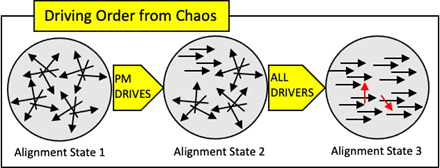By Robin Hornby
June 28, 2023
Collaborative working has become something of a buzzword. Every project would claim it is their intention. But more than good intentions are needed. In this second article, Robin explores the concept of alignment, specific techniques the project manager can apply to achieve it, and the benefits it can bring in addition to the promise of enabling productive owner/provider engagement.
Introduction
Alignment is an enabler of collaborative engagement, where major productivity gains are to be found. I hesitate to call it a prerequisite because project management (PM) is not a science. But because a well-aligned project enjoys benefits, it’s a legitimate goal for the project manager (the PM) to pursue in any case.
The degree of benefit is dependent on the degree of alignment. The diagram, Driving Order from Chaos, provides a visual for a dilemma familiar to PMs at the beginning of every complex project. The objective, of course, is to have everyone ‘pointing in the same direction’.
The skilled PM can do much to create this. Project team alignment is a classic starting point because dealing with unmotivated team members who believe the project is either ill-conceived or technically misdirected present an immediate problem. A greater challenge is misaligned stakeholders who disagree with the project justification or its basic objectives and can delay the project or even threaten its feasibility. And business alignment is so significant I will devote a complete future article to it.

A good leader knows an essential part of the role is to build unity of purpose while facing legitimate diversity of opinion. Before turning to helpful techniques, I should acknowledge leadership style helps deal with these challenges, and versatile behavior will allow direction appropriate to the circumstances to be adopted; sometimes consensus-driven, sometimes democratic, and sometimes dictatorial. A touch of charisma can also help!
Rules and Techniques
While working on our charisma, there are some concrete rules and techniques to complement the PM’s ‘soft’ skills. Here are six techniques construed from discussion on alignment in my earlier book Ten Commandments of Project Management1 and should move the project from alignment state 1 to at least state 2:
- Make Tasks Meaningful. Expand project objectives into deliverables and activities so work assignments can be traced and identified as relevant and meaningful.
- Attend to Personal Objectives. A dynamic approach is to align assignments with a team member’s or stakeholder’s personal objectives to create a ‘win-win’. Or as King Ferdinand II allegedly said, “He serves his king the best who also serves himself”.
- Manage Owner Expectations. Keep sponsor and stakeholder expectations in line with forecast results. A cliché maybe, but PM action is still required. Some ideas:
- Develop strong objectives statements with the owner at the outset of the project.
- Use the charter to link project objectives to benefits and ensure the owner’s responsibilities are clear.
- Gain trust by planning and meeting near-term low risk objectives.
- Recap objectives in all project presentations, specifically during team or stakeholder initiation.
- Under-promise and over-deliver.
Remember, if unrealistic expectations are uncorrected or left ambiguous, it will come back to haunt you.
- Know Where You Stand. Make sure you have a clear position on all aspects of the project and others understand it. Avoid ambiguity and use techniques such as Pareto’s principle (the 80/20 Rule), progressive elaboration, and baseline defense.
- No Fantasy Plans. Do not load the far reaches of the project plan with unknowable details which may create an illusion of accuracy and imply a false commitment you will regret. From my experience, every non-trivial project possesses a planning horizon beyond which there are so many unsettled variables that detailed planning is an empty intellectual exercise. Valid alternatives are:
- If further out than six months, only issue plans for higher-level elements such as phases, deliverables, and key milestones.
- Use the rolling wave.
- Use product releases as a ‘divide and conquer’ strategy.
- Include contingency rather than bogus detailed plans.
- Negotiate detailed schedule and effort if you must but vary the scope (if you can!).
To summarize – do not plan the unknowable.
- Realistic Assumptions Certainly, make assumptions (you must), but avoid over-optimistic, low probability or false assumptions. These will mislead you and everyone else. Build a support kit you can reuse, such as the following:
- An assumption can never be considered true. It all boils down to risks and probabilities.
- Use a checklist for common assumptions such as stakeholders’ responsibilities, team skills, complexity, facilities, interface boundaries, approvals, decisions, technical support, component compatibilities, etc.
- Insist on a set of assumptions to accompany every estimate you review or prepare.
- Use standard estimating grids to force explicit complexity assumptions.
- Be prepared to coach technical staff in formulation of assumptions.
- Write down assumptions – if you don’t, stakeholders will form assumptions to fit their personal views.
Unrealistic or ambiguous assumptions left unchallenged can be as damaging to a project as no assumptions at all. Valid assumptions require hard work.
Each one of these six rules or techniques require disciplined PM work and good quality leadership. They offer point solutions to specific alignment issues such as the rationale for the project, what constitutes success, project complexities, future uncertainties, and what is reasonable to assume. On these matters the PM, team, and some stakeholders may be brought to the same page, improving communication, decision-making and problem-solving. Unfortunately, from a corporate perspective, the results do not always get the project to alignment state 3. I have come to realize, useful as these techniques are, there are limits to what the PM acting alone can achieve, much as we would like to think otherwise.
Conclusion
I have often likened a fully aligned project to an unstoppable locomotive heading towards its destination. A trifle hyperbolic, but if you’ve been lucky enough to work on one you will know my meaning. Alignment state 3 (yes, the arrows suggest there are always a few not totally onboard) can sometimes be achieved by a well-functioning organization without the help of additional drivers. But to guarantee it, we cannot leave it all to the PM.
The organization must be slightly reconfigured to recognize project work as a fact of corporate existence (like quality, safety, human resources, corporate ethics, public relations etc.) and a degree of responsibility driven into the organization. Thus, many administrative and management practices move from the sole burden of the PM to be shared with the owner.
I was impelled to write my recent book, A Concise Guide to Project Collaboration2, to provide a practical template for such an initiative, which I call the Delivery Organization. It is aimed at corporate managers, not just the PMs, and is designed for both in-house and vendor providers. Managers need to understand the concept and its benefits so they can give their authority for implementation to the PMs, who can use the template the book describes.
References
[1] Hornby, Robin. 2004. Ten Commandments of Project Management: A brief guide to the art of righteous project management, TMI. https://www.tmipm.com/books
[2] Hornby, Robin. 2023. A Concise Guide to Project Collaboration: Building a Delivery Organization, Routledge (Focus Series). https://www.routledge.com/A-Concise-Guide-to-Project-Collaboration-Building-a-Delivery-Organization/Hornby/p/book/9781032435459
About the Author
Robin Hornby has worked in Information Technology for over 40 years, taught project management at Mount Royal University for 12 years and maintained a consulting practice. He worked across Canada and internationally, was a long-time holder of the PMP designation, and presented frequently at PMI symposia. He pioneered many delivery management practices and is the author of four books. In this series of articles, Robin develops ideas found in his most recent book, A Concise Guide to Project Collaboration. The series was first published in the PM World Journal.
Early Registration for IPM Day is now open! Get IPM Day for only $69 now through September 1st! Register here.
Disclaimer: The ideas, views, and opinions expressed in this article are those of the author and do not necessarily reflect the views of International Institute for Learning or any entities they represent.



